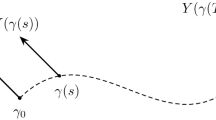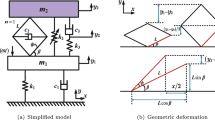Abstract
In this work we present computational methods for examining dynamical systems. We focus on those systems being characterized by slow–fast vector fields or corresponding differential algebraic equations that commonly occur in physical applications. In the latter ones scientists usually consider a manifold of admissible physical states and a vector field describing the time evolution of the physical system. The manifold is typically implicitly defined within a higher-dimensional space by a system of equations. Certain physical systems, such as relaxation oscillators, perform sudden jumps in their state evolution when they are forced into an unstable state. The main contribution of the present work is to model the dynamical evolution incorporating the jumping behavior from a perspective of computational geometry which not only provides a qualitative analysis but also produces quantitative results. We use geodesic polar coordinates (GPC) to numerically obtain explicit parametrizations of the implicitly defined manifold and of the relevant jump and hit sets. Moreover, to deal with the possibly high co-dimension of the considered implicitly defined manifold we sketch how GPC in combination with the cut locus concept can be used to numerically obtain an essentially injective global parametrization. This allows us to parametrize and visualize the dynamical evolution of the system including the aforementioned jump phenomena. As main tools we use homotopy approaches in conjunction with concepts from differential geometry. We discuss how to numerically realize and how to apply them to several examples from mechanics, electrical engineering and biology.






















Similar content being viewed by others
Explore related subjects
Discover the latest articles and news from researchers in related subjects, suggested using machine learning.Notes
Note that contrary to other common uses of the term algebraic, in this context \(f\) and \(g\) are not required to be polynomial functions.
References
Allgower, E.L., Georg, K.: Introduction to numerical continuation methods. Classics in applied mathematics. SIAM (2003). doi:10.1137/1.9780898719154.
Dey, T.K., Li, K.: Cut locus and topology from surface point data. Proceedings of the Twenty-fifth Annual Symposium on Computational Geometry. SCG ’09, pp. 125–134. ACM, New York (2009)
do Carmo, M.P.: Riemannian Geometry. Birkhauser, Boston (1992).
Golub, G., Kahan, W.: Calculating the singular values and pseudo-inverse of a matrix. J. SIAM Numer. Anal. Ser. B 2, 205–224 (1965)
Guckenheimer, J., Haiduc, R.: Canards at folded nodes. Mosc. Math. J. 5(1), 91–103 (2005)
Guckenheimer, J., Hoffman, K., Weckesser, W.: Numerical computation of canards. Int. J. Bifurc. Chaos 10(12), 2669–2687 (2000)
Guckenheimer, J., Hoffman, K., Weckesser, W.: Global analysis of periodic orbits in the forced van der Pol equation. In: Broer H.W., Krauskopf B., Vegter G. (eds.) Global Analysis of Dynamical Systems-Festschrift Dedicated to Floris Takens for his 60th Birthday, pp. 261–276. IOP Press (2003)
Guillemin, V., Pollack, A.: Differential Topology, vol. 370. American Mathematical Society. (Englewood Cliffs, N.J.: Prentice-Hall, 1974) (2010)
Gutschke, M.: Untersuchungen zur Berechnung kürzester Verbindungswege auf gekrümmten Flächen. Diploma thesis, Welfenlab, Leibniz Universität Hannover (2004).
Gutschke, M., Vais, A., Wolter, F.-E.: A geometrical framework to capture the dynamical evolution of slow-fast vector fields. In: Proceedings NASAGEM Workshop-Computer Graphics International (2013). http://welfenlab.de/fileadmin/gutschke2013.pdf. Accessed 11 June 2013
Hodgkin, A.L., Huxley, A.F.: A quantitative description of membrane current and its application to conduction and excitation in nerve. J. Physiol. 117, 500–544 (1952)
Hodgkin, A.L., Huxley, A.F.: Currents carried by sodium and potassium ions through the membrane of the giant axon of Loligo. J. Physiol. 116, 449–472 (1952)
Katok, A., Hasselblatt, B.: Introduction to the Modern Theory of Dynamical Systems, vol. 54. Cambridge University Press, Cambridge (1997)
Mathis, W., Blanke, P., Gutschke, M., Wolter, F.-E.: Nonlinear electric circuit analysis from a differential geometric point of view. ITG-Fachbericht-ISTET 2009, 30167 (2009)
Memoli, F., Sapiro, G., Osher, S.: Solving variational problems and partial differential equations mapping into general target manifolds. J. Comput. Phys. 195, 263–292 (2004)
Nass, H.: Medial axis on Riemannian manifolds. Ph.D. thesis, Leibniz Universitaet Hannover (2007).
Nass, H., Wolter, F.-E., Dogan, C., Thielhelm, H.: Computation of geodesic voronoi diagrams in 3-space using medial equations. In: Proceedings of NASAGEM, 26 Oct 2007 (2007).
Nass, H., Wolter, F.-E., Thielhelm, H., Dogan, C.: Medial axis inverse transform in 3-dimensional riemannian complete manifolds. In: Proceedings of NASAGEM, Hannover, 26 Oct 2007 (2007).
Poincaré, H.: Sur les Lignes Géodésiques des Surfaces Convexes. Trans. Am. Math. Soc. 6, 237–274 (1905)
Rausch, T.: Untersuchungen und Berechnungen zur Medialen Achse bei berandeten Flaechenstücken. Ph.D. thesis, Universitaet Hannover (1999).
Rausch, T., Wolter, F.-E., Sniehotta, O.: Computation of medial curves on surfaces. Math. Surf. 7, 43–68 (1997)
Sinclair, R., Tanaka, M.: Loki: software for computing cut loci. Exp. Math. 11(1), 1–25 (2002)
Steward, I., Woodcock, A.E.R.: On Zeeman’s equations for the nerve impulse. Bull. Math. Biol. 43, 279–325 (1981)
Tchizawa, K.: An analysis of nonlinear systems with respect to jump. Yokohama Math. J. 32, 203–214 (1984)
Thielhelm, H., Vais, A., Brandes, D., Wolter, F.-E.: Connecting geodesics on smooth surfaces. Vis. Comput. 28(6–8), 529–539 (2012)
Thiessen, T.: Mathis: geometric dynamics of nonlinear circuits and jump effects. Int. J. Comput. Math. Electr. Electron. Eng. 30(4), 1307–1318 (2011)
Thiessen, T., Gutschke, M., Blanke, P., Mathis, W., Wolter, F.-E.: Numerical analysis of relaxation oscillators based on a differential geometric approach. In: International Conference on Signals and Electronic Systems, pp. 209–212 (2010).
Thiessen, T., Gutschke, M., Blanke, P., Mathis, W., Wolter, F.-E.: A numerical approach for nonlinear dynamical circuits with jumps. In: European Conference on Circuit Theory and Design (2011).
Thiessen, T., Gutschke, M., Blanke, P., Mathis, W., Wolter, F.-E.: Differential geometric methods for jump effects in nonlinear circuits. In: 20th Edition of the Nonlinear Dynamics of Electronic Systems (2012).
Thom, R.: Structural Stability and Morphogenesis. W.A. Benjamin, inc., Advanced Book Program, Reading (1975)
Wolter, F.-E.: Distance function and cut loci on a complete Riemannian manifold. Arch. Math. 1(32), 92–96 (1979)
Wolter, F.-E.: Cut loci in bordered and unbordered Riemannian manifolds. Ph.D. thesis, TU Berlin (1985).
Wolter, F.-E.: Cut locus and medial axis in global shape interrogation and representation. MIT Design Laboratory Memorandum 92–2 and MIT National Sea Grant Library Report. MIT, Dec 1993 (1992) (revised version).
Wolter, F.-E., Tuohy, S.T.: Approximation of high-degree and procedural curves. Eng. Comput. 8(2), 61–80 (1992)
Wolter, F.-E., Tuohy, S.T.: Curvature computations for degenerate surface patches. Comput. Aided Geom. Des. 9(4), 241–270 (1992)
Wolter, F.-E., Blanke, P., Thielhelm, H., Vais, A.: Computational differential geometry contributions of the welfenlab to grk 615. In: Modelling, Simulation and Software Concepts for Scientific-Technological Problems, vol. 57, pp. 211–235. Springer (2011).
Zangwill, W.I., Garcia, C.B.: Pathways to solutions, fixed points, and equilibria. Prentice-Hall, Englewood Cliffs (1981)
Zeeman, E.C.: Catastrophe Theory: Selected Papers, 1972–1977. Addison-Wesley, Reading (2000).
Acknowledgments
The research in this article was partially supported by the German Research Foundation (DFG), Project ”Differentialgeometrische Methoden zur Analyse nichtlinearer elektronischer Schaltungen und deren Visualisierung”.
Author information
Authors and Affiliations
Corresponding author
Rights and permissions
About this article
Cite this article
Gutschke, M., Vais, A. & Wolter, FE. Differential geometric methods for examining the dynamics of slow-fast vector fields. Vis Comput 31, 169–186 (2015). https://doi.org/10.1007/s00371-014-1036-0
Published:
Issue Date:
DOI: https://doi.org/10.1007/s00371-014-1036-0




